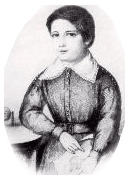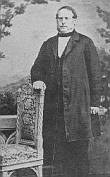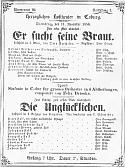| |
|
1835 |
 On
7 October, Felix August Bernhard Draeseke is born in Coburg to
Theodor Draeseke and his wife Maria (born Hanstein). Eight
days later, Draeseke's mother, Maria, dies of a stroke. On
7 October, Felix August Bernhard Draeseke is born in Coburg to
Theodor Draeseke and his wife Maria (born Hanstein). Eight
days later, Draeseke's mother, Maria, dies of a stroke. The
baptism (Lutheran) of Felix Draeseke takes place on 25
November. |
| 1840
|
On
1 March, Theodor Draeseke marries Emilie Bähring and she becomes
stepmother to Felix. |
| 1841-2
|
 Young
Felix is taken on his first trip away from Coburg, to Meiningen
and the following year the family brings Draeseke on an extended
trip to Leipzig, Dresden and Potsdam. Young
Felix is taken on his first trip away from Coburg, to Meiningen
and the following year the family brings Draeseke on an extended
trip to Leipzig, Dresden and Potsdam. Felix
makes the acquaintance of his grandfather, the theologian Bernhard
Draeseke, and several aunts.
|
|
1843 |
Draeseke
composes his first piece of music, a "Kleiner Marsch" (Little
March) - now lost - for his father's birthday. |
|
1846 |
After living half of the year in
the Coburg suburb of Rodach, the Draeseke family returns to Coburg
and Felix
finishes his elementary schooling. |
|
1848 |
Draeseke
enters the prestigious "Casimirianum" for
completion of his secondary education and begins to seriously
study music. |
| 1849 |
 During the summer Draeseke makes an
extended journey around Germany with his grandfather and along
the way is introduced to such musical illuminaries of the day as
Ferdinand
Hiller and Aloys Schmitt. It is declared that Draeseke was named
after Felix Mendelssohn. For his father's birthday Draeseke composes
his Overture to "Niklas Zriny", a play by Theodor Koerner, for
piano four hands, the earliest extant work of Draeseke (WoO 1). During the summer Draeseke makes an
extended journey around Germany with his grandfather and along
the way is introduced to such musical illuminaries of the day as
Ferdinand
Hiller and Aloys Schmitt. It is declared that Draeseke was named
after Felix Mendelssohn. For his father's birthday Draeseke composes
his Overture to "Niklas Zriny", a play by Theodor Koerner, for
piano four hands, the earliest extant work of Draeseke (WoO 1). |
| 1850 |
For his father's 42nd birthday Draeseke
composes the song "Vöglein, wohin so schnell" (Little Bird, Where
Are You Off To So Fast, lost). |
| 1851 |
During the Christmas holidays, Draeseke,
now 16 years old, declares his calling to be music and his intention
to have a professional career in music. |
| 1852 |
At the beginning of April, Draeseke
passes the entrance examination for the Leipzig Conservatory.
For
the next three years he studies theory and harmony with Benjamin
Papperitz and Friedrich Richter, piano by Louis Plaidy and Ignaz
Moscheles, composition with Julius Rietz, and music history with
Franz Brendel.
At Easter, Draeseke visits Weimar for one of the
early
performances of Wagner's "Lohengrin" (under Liszt) and
is convinced that Wagner's direction is the one that he will follow.
By July, Draeseke is already attempting to fashion a libretto from
Emanuel Geibel's play "Sigurd Kind" (Child Sigurd) for a
first attempt at opera. By the end of the year, Draeseke produces
a
string
quartet in C minor, some piano pieces, songs, and possibly also
a choral psalm setting, all of which are either destroyed or
lost
over the years. |
| 1853 |
By February Draeseke completes the
overture to his projected opera "König Sigurd" (King Sigurd) and,
upon examining it, his father makes note of Wagner's influence.
In September Draeseke travels to Berlin where he is diagnosed with
an ear infection, the effects of which eventually lead to deterioration
of hearing and almost complete deafness in later years. While in
Berlin, Draeseke makes the acquaintance of Hans von Bülow. |
| 1854 |
Under Rietz's tutelage Draeseke begins
his first attempt at a symphony, a Symphony in C major (Jugendsinfonie),
as well as a "Lustpiel" Overture (Comedy Overture) and on his own,
two other overtures which are the beginnings of the later symphonic
poems, "Julius Caesar" and "Frithjof".
Draeseke becomes dissatisfied
with the conservative outlook of the Leipzig Conservatory. |
| 1855
|
Draeseke leaves the Leipzig Conservatory
at Easter and completes his Symphony in C major shortly thereafter
and by the middle of May a libretto for "König Sigurd" is declared
finished. Impressed by his former student's insights and abilities,
Franz Brendel engages Draeseke to write articles and reviews for
the "Neue Zeitschrift für Musik", of which Brendel is general editor. |
| 1856
|
Draeseke's
first essay on Wagner, "Der Dichter und der Componist"
(The Poet and The Composer) in Book 2 of Volume I of "Anregungen
für Kunst, Leben und Wissenschaft" (Stimuli for Discussion of
Art, Life and Science), a recently founded publication by Franz
Brendel.
 On 11 November, sandwiched between two comedies at the Court Theater in Coburg, Draeseke's Symphony
in C major ("Jugendsinfonie") is given its premiere under, it
is assumed, the direction of one, August Langert. The performance
is
reported as successful, but Draeseke destroys the work a few years
later. All that is known of this performance comes from Draeseke's
own and strangely cryptic account in his "Lebenserinnnerungen" (Reminiscences
of My Life); Erich Roeder also makes reference to a review in the "Neue
Zeitschrift für Musik" - 26 December 1856, p. 280. On 11 November, sandwiched between two comedies at the Court Theater in Coburg, Draeseke's Symphony
in C major ("Jugendsinfonie") is given its premiere under, it
is assumed, the direction of one, August Langert. The performance
is
reported as successful, but Draeseke destroys the work a few years
later. All that is known of this performance comes from Draeseke's
own and strangely cryptic account in his "Lebenserinnnerungen" (Reminiscences
of My Life); Erich Roeder also makes reference to a review in the "Neue
Zeitschrift für Musik" - 26 December 1856, p. 280. 
|
| 1857
|
Draeseke
resides in Berlin and becomes involved in Bülow's concert
activities on behalf of the New German School and Liszt's music
in particular. On 25 February Draeseke meets Liszt for the
first time, at a concert of the Gewandhaus Orchestra in Leipzig.
On 2 March,
Draeseke shows Liszt the almost completed score of his opera "König
Sigurd" which makes a deep impression on Liszt; the opera is completed
31 July and its libretto is printed in October. At the beginning
of September Draeseke takes up his first residence in Dresden,
contemplates a symphonic poem "Das zerstörte Jerusalem" (Jerusalem
Destroyed, after Torquato Tasso) but abandons the idea despite
already assembled
materials. |
| 1858
|
Draeseke
continues his analyses of Liszt's symphonic poems for Brendel's "Anregungungen für Kunst, Leben und Wissenschaft" begun with "Prometheus"
in November, 1857. During the summer Draeseke makes the acquaintance
of Hans von Bronsart (Hans Bronsart von Schellendorf).
Liszt invites
Draeseke to Weimar because of interest in "Sigurd". A piece d'occasion
from the visit, a setting of Heinrich Heine's "König Wiswamitra"
(King Wiswamitra), has disappeared. In December, after visits to
Coburg and Berlin, Draeseke travels to Weimar and witnesses the
catastrophe and scandal attending Liszt's premiere of "Der Barbier
von Bagdad" of Peter Cornelius. Liszt's withdrawal from Weimar dashes
all hopes for a production of Draeseke's opera "König Sigurd" (WoO
2). |
|
1859 |
Draeseke
completes his official Opus 1, "Helges Treue" (Helge's
Faithfulness) for voice and piano on a ballad by Moritz von Strachwitz,
which is dedicated to Franz Liszt. Liszt is so enthusiastic that
he arranges for the work's publication and later makes it over
into
a melodrama. Draeseke travels to Luzern andLeipzig. With
a letter of introduction from Liszt, Draeseke is introduced to
Richard
Wagner in July for the first time and is privileged to witness
the finishing of Wagner's "Tristan und Isolde". A month's association
with Wagner alters Draeseke's ideas concerning the essence of
melody.
After returning to Dresden, Draeseke completes his setting for
soprano, male chorus and orchestra of "Germania an ihre Kinder" (Germania
To Her Children) an ode by Heinrich von Kleist. Soon thereafter
he begins the symphonic poem "Frithjof", begins and abandons a
similar project involving Heine's "Die Loreley", and completes
an overture to the comedy "Rubens und der Bauer" (Rubens and the
Peasant) by his friend Adolf Stern. This is later turned
into the "Carnevalsouvertüre"
(Carnival Overture), though no score for either survives. |
| 1860
|
The
year opens with mention that Draeseke has begun a symphonic poem
on the subject of Shakespeare's "Julius Caesar" which,
in its first version, is completed 11 May. After a trip
with Hans and Cosima
von Bülow to Prague in early summer, Draeseke composes incidental
music for a projected Dresden performance of Kleist's drama "Die
Hermannsschlacht" (Hermann's Battle or The Battle of Arminius),
WoO 4. A "Germania" Cantata after Strachwitz for Male Chorus
and Orchestra (WoO 3b) is composed but is later destroyed. |
| 1861
|
 By
1861 Draeseke completes the three volumes of songs intended for
publication as Op. 2; only the first two volumes are published
with
that opus, "Märzblumen" and "Cypressen" (March Flowers and Cypresses);
the third, "Heliotropen" (Heliotropes) appears much later as Op. 76
and with a different title; WoO 5, "Frage und Antwort" (Question
and Answer) is dropped from this third volume and published
without
opus number in a music magazine in 1886. Draeseke orchestrates "Helges
Treue" for a later performance that year at Weimar, but the orchestra
materials do not arrive in time. Draeseke instead makes his debut
as conductor in the premiere of his "Germania" Cantata (WoO 3b); the same concert closes with von Bülow conducting the "Germania" March (WoO 3c). The concert
causes an uproar and earns Draeseke the countenance of the "besonders
gefährliche Bestie" (the especially dangerous beast) among the
members of the New German School. He accompanies Wagner to Eisenach
in August,
and in November is able to hear orchestral music of Berlioz, which
impresses him greatly. On 18 November he completes his revision
of "Julius
Caesar" (WoO 6). By
1861 Draeseke completes the three volumes of songs intended for
publication as Op. 2; only the first two volumes are published
with
that opus, "Märzblumen" and "Cypressen" (March Flowers and Cypresses);
the third, "Heliotropen" (Heliotropes) appears much later as Op. 76
and with a different title; WoO 5, "Frage und Antwort" (Question
and Answer) is dropped from this third volume and published
without
opus number in a music magazine in 1886. Draeseke orchestrates "Helges
Treue" for a later performance that year at Weimar, but the orchestra
materials do not arrive in time. Draeseke instead makes his debut
as conductor in the premiere of his "Germania" Cantata (WoO 3b); the same concert closes with von Bülow conducting the "Germania" March (WoO 3c). The concert
causes an uproar and earns Draeseke the countenance of the "besonders
gefährliche Bestie" (the especially dangerous beast) among the
members of the New German School. He accompanies Wagner to Eisenach
in August,
and in November is able to hear orchestral music of Berlioz, which
impresses him greatly. On 18 November he completes his revision
of "Julius
Caesar" (WoO 6). |
|
1862 |
During
a visit to Leipzig in February, Draeseke writes an overture (WoO
8) for the birthday of Prince Constantine of Hohenzollern-Hechingen
which, when performed, is not well received, either by the
audience
or the dedicatee. Draeseke completes few new works after June and
in September decides to move to Switzerland, an undertaking
evidently
much influenced by his Coburg friend and colleague August Langert.
On 17 October Draeseke leaves Germany for Switzerland,
but for the
French-speaking part, la Suisse romande. Among the works completed
before the end of the year are the "Fantasiestücke in Walzerform"
(Fantasy Pieces in Waltz Form, Op. 3), and one of the two "Konzertwalzer" (Concert
Waltzes, Op. 5), and a first version of the Op.
6 Sonata quasi Fantasia in C# minor for Piano. |
| Note: |
 : This icon indicates that there is original material regarding this event in the Ebert collection. Click the icon to view those pages. : This icon indicates that there is original material regarding this event in the Ebert collection. Click the icon to view those pages. |
|
|
 On
7 October, Felix August Bernhard Draeseke is born in
On
7 October, Felix August Bernhard Draeseke is born in  Young
Felix is taken on his first trip away from Coburg, to Meiningen
and the following year the family brings Draeseke on an extended
trip to Leipzig, Dresden and Potsdam.
Young
Felix is taken on his first trip away from Coburg, to Meiningen
and the following year the family brings Draeseke on an extended
trip to Leipzig, Dresden and Potsdam.  During the summer Draeseke makes an
extended journey around Germany with his grandfather and along
the way is introduced to such musical illuminaries of the day as
Ferdinand
Hiller and Aloys Schmitt. It is declared that Draeseke was named
after Felix Mendelssohn. For his father's birthday Draeseke composes
his Overture to "Niklas Zriny", a play by Theodor Koerner, for
piano four hands, the earliest extant work of Draeseke (WoO 1).
During the summer Draeseke makes an
extended journey around Germany with his grandfather and along
the way is introduced to such musical illuminaries of the day as
Ferdinand
Hiller and Aloys Schmitt. It is declared that Draeseke was named
after Felix Mendelssohn. For his father's birthday Draeseke composes
his Overture to "Niklas Zriny", a play by Theodor Koerner, for
piano four hands, the earliest extant work of Draeseke (WoO 1). 
 By
1861 Draeseke completes the three volumes of songs intended for
publication as Op. 2; only the first two volumes are published
with
that opus, "Märzblumen" and "Cypressen" (March Flowers and Cypresses);
the third, "Heliotropen" (Heliotropes) appears much later as Op. 76
and with a different title; WoO 5, "Frage und Antwort" (Question
and Answer) is dropped from this third volume and published
without
opus number in a music magazine in 1886. Draeseke orchestrates "Helges
Treue" for a later performance that year at Weimar, but the orchestra
materials do not arrive in time. Draeseke instead makes his debut
as conductor in the premiere of his "Germania" Cantata (WoO 3b); the same concert closes with von Bülow conducting the "Germania" March (WoO 3c). The concert
causes an uproar and earns Draeseke the countenance of the "besonders
gefährliche Bestie" (the especially dangerous beast) among the
members of the New German School. He accompanies Wagner to Eisenach
in August,
and in November is able to hear orchestral music of Berlioz, which
impresses him greatly. On 18 November he completes his revision
of "Julius
Caesar" (WoO 6).
By
1861 Draeseke completes the three volumes of songs intended for
publication as Op. 2; only the first two volumes are published
with
that opus, "Märzblumen" and "Cypressen" (March Flowers and Cypresses);
the third, "Heliotropen" (Heliotropes) appears much later as Op. 76
and with a different title; WoO 5, "Frage und Antwort" (Question
and Answer) is dropped from this third volume and published
without
opus number in a music magazine in 1886. Draeseke orchestrates "Helges
Treue" for a later performance that year at Weimar, but the orchestra
materials do not arrive in time. Draeseke instead makes his debut
as conductor in the premiere of his "Germania" Cantata (WoO 3b); the same concert closes with von Bülow conducting the "Germania" March (WoO 3c). The concert
causes an uproar and earns Draeseke the countenance of the "besonders
gefährliche Bestie" (the especially dangerous beast) among the
members of the New German School. He accompanies Wagner to Eisenach
in August,
and in November is able to hear orchestral music of Berlioz, which
impresses him greatly. On 18 November he completes his revision
of "Julius
Caesar" (WoO 6).